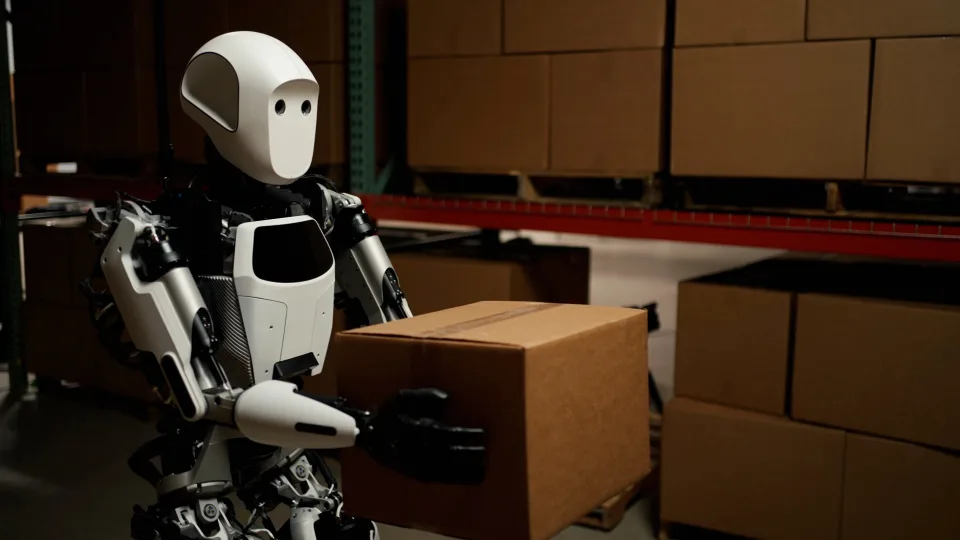Introducing Apollo, the new workforce robot by Apptronik.
This android is specifically designed to work alongside humans in various environments. Initially focused on logistics and manufacturing, Apollo can move and carry cases and totes. However, Apptronik envisions Apollo expanding into other sectors such as construction, oil and gas, electronics production, retail, home delivery, and elder care. This revolutionary 5-foot-8, 160-lb robot can lift up to 55 lbs with its optimized efficiency and lightweight arms. With swappable batteries lasting up to four hours, Apollo offers greater flexibility and operational efficiency compared to other robots that require wall charging. Apptronik has built modularity into Apollo’s design, allowing users to customize its functionality as a bi-pedal walking humanoid, a torso on wheels, or a stationary mount. Additionally, Apollo features digital panels on its face and chest to create a friendly and familiar presence for workers. Embrace the future of automation with Apollo by Apptronik.
The Rise of Humanoid Robots
Humanoid robots have long captured the imagination of science fiction enthusiasts and tech visionaries alike. They represent the fusion of robotics and artificial intelligence to create machines that can mimic human movements and interactions. While we’ve seen various humanoid robots in research and development labs, bringing them to the consumer market has been a challenging endeavor.
Apptronik’s Apollo: A New Challenger
Apptronik, a company known for its work in advanced robotics and automation, has unveiled Apollo, a humanoid robot designed for real-world applications. What sets Apollo apart is its focus on combining advanced robotics with AI-powered autonomy to create a machine capable of a wide range of tasks.
Key Features of Apptronik’s Apollo:
- Human-Like Mobility: Apollo boasts a design that closely mimics human limbs and joints, allowing it to move with remarkable dexterity and agility.
- AI-Powered Autonomy: The robot is equipped with advanced artificial intelligence algorithms that enable it to navigate complex environments, make decisions in real time, and adapt to changing situations.
- Versatility: Apptronik envisions Apollo being used in a variety of industries, from manufacturing and logistics to healthcare and entertainment.
- Safety and Collaboration: The robot is designed with safety in mind, making it suitable for close collaboration with human workers. This makes it a potential game-changer in industries where human-robot collaboration is essential.
- Customization: Apptronik aims to provide a platform that allows users to customize Apollo’s capabilities to suit their specific needs, potentially opening up a world of possibilities for robotics enthusiasts and businesses alike.
Challenging the Tesla Paradigm
Elon Musk and Tesla have been at the forefront of autonomous vehicles and AI-driven technology. Musk’s vision of self-driving electric cars has reshaped the automotive industry and made Tesla a household name. However, Apptronik’s Apollo represents a different perspective on AI and automation.
While Tesla’s focus is primarily on autonomous vehicles, Apptronik’s Apollo is a testament to the versatility of AI and robotics. It demonstrates that advanced robotics, with human-like mobility and AI-powered autonomy, can be applied in a wide range of industries beyond transportation.
The Future of Humanoid Robots
The emergence of Apollo underscores the rapid progress being made in the field of robotics. As humanoid robots become more sophisticated and capable, they have the potential to transform industries and improve the quality of life in countless ways.
From aiding in disaster relief efforts to revolutionizing manufacturing and enhancing healthcare, the applications for humanoid robots like Apollo are virtually limitless. The race to bring these robots to market not only highlights their potential but also signals a shift in the way we think about automation and artificial intelligence.
As we look to the future, the competition between companies like Tesla and newcomers like Apptronik promises to push the boundaries of what is possible in the world of robotics. Whether you’re a tech enthusiast or someone intrigued by the possibilities of humanoid robots, Apollo’s arrival is a significant milestone in the ongoing evolution of AI and automation.
